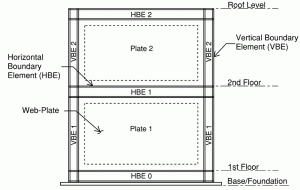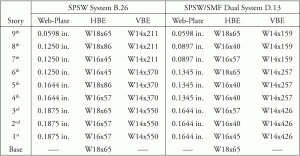The steel plate shear wall (SPSW) presents a viable structural system to resist lateral forces during earthquakes. A, SPSW is a lateral force resisting system (LFRS) composed of a thin steel web-plate bounded by and attached to a surrounding portal frame. As shown in the Figure, the frame beams are termed Horizontal Boundary Elements (HBEs) and the adjacent columns are the Vertical Boundary Elements (VBEs). The thin unstiffened web-plates are expected to buckle in shear at relatively low lateral load levels and develop tension field action for ductility and energy dissipation. This type of SPSW is referred to as a “Special Steel Plate Shear Wall” LFRS in the AISC Seismic Provisions for Structural Steel Buildings (AISC 341-10).
Current Seismic Provisions do not directly consider the plate frame interaction and assume that the web-plates resist the entire design base shear. The LFRS Seismic Provisions capacity design methodology is then used for design of the HBEs and VBEs bounding the web-plate. This combination often leads to uneconomical SPSW design, especially in regards to the HBE and VBE sizing. However, it is possible to design efficient SPSW buildings within the limitations of the governing codes, ASCE 7-10 and AISC 341-10.
This discussion will help navigate ASCE 7-10’s provisions and commentary which are currently lacking in terms of SPSWs. The two seismic force-resisting system types available for selection from Table 12.2-1 of ASCE 7-10, B.26 and D.13, can be broken down further into to a total of three configurations. First, the standard SPSW building frame system (Table 12.2-1, B.26) has a response modification coefficient, R, of 7 and requires the boundary elements to be detailed similar to intermediate moment frames. The dual SPSW and special moment frame (SMF) system (Table 12.2-1, D.13) has an R of 8 and requires the full detailing requirements of SMFs. ASCE’s lack of commentary regarding how the SPSW dual system may be utilized is likely one of the reasons engineers seldom select SPSWs as their primary LFRS. Structural engineers are accustomed to seeing the SMF and concrete shear wall dual system used in high-rise construction. Although it is possible to utilize the SPSW in a similar manner, the efficiency of the SPSW does not come into its own unless the SPSW and SMF dual system is also designed within a single frame. It is important to note that all SPSWs, independent of which system is selected, follow a capacity design approach based on the expected web-plate strength and assumed plastic hinge formation at the ends of each HBE.
In the single frame dual system case, the SPSW boundary elements are simply detailed as SMF elements. Past research, including that referenced within the commentary of the Seismic Provisions, indicate that the VBEs of code designed SPSW typically contribute to more than 25% of the total frame shear. The Seismic Provisions’ SPSW basis of design commentary states, “the yielding of boundary elements contributed approximately 25% to 30% of the total load strength of the system.” In most cases, selection of the SPSW dual system where the boundary elements are assumed to carry at least 25% of the base shear will result in a significantly more cost effective LFRS. This is due to the compounding effects from the capacity based design procedure for SPSWs. The Seismic Provisions require the web-plate be the only element within this frame designed to resist the code level seismic forces; thus oversizing the web-plate results in excessive boundary elements sizing. Simply selecting the dual system and sizing the web-plate for 75% of the total frame shear will reduce the size of all frame elements. When following the capacity based design procedures for a SPSW, the boundary elements will in most cases already be sized adequately to meet all the SMF requirements to resist 25% of the total frame shear. An SPSW element size comparison for a nine-story prototype building with 6 SPSW frames in each orthogonal direction is shown in the Table. For reference, this prototype building is similar to that of the SAC-Project Los Angeles structure.
When determining building base shear, ASCE 7-10 does not offer an ideal starting point for initial SPSW element sizing. ASCE 7-10’s approximate fundamental period calculation method is inaccurate and overly conservative. Updating the approximate fundamental period estimation is probably the simplest code revision recommended to increase SPSW viability as an LFRS for designers to select. Currently SPSWs are lumped into the “All Other Structural Systems” category by ASCE 7-10 (Table 12.8-2) with other systems of far less ductility. The 2012 IBC SEAOC Structural/Seismic Design Manual, published by the Structural Engineers Association of California (SEAOC), suggests that for SPSW structures, engineers should use the upper limit of the approximate fundamental period, Tmax per ASCE 7-05 for initial SPSW design and later validated with the use of computer modeling. Although not written anywhere in the commentary of ASCE 7-10, this assumption does align with both published research and professional design experience.
Simply using Tmax for SPSW period approximation is an acceptable temporary guideline. However, past research aimed specifically at the period approximation of SPSW structures looks further into more substantial changes in the code or creating additional approximation methods for design professionals. There is adequate research on fundamental period approximation of SPSW systems for ASCE and other code councils to update the period approximation equations for SPSW buildings. Until more provisions are added for SPSW structures, the use of Tmax is good starting point for designers.
In summary listed below are a few key steps for efficient design of SPSW systems for buildings over 2-stories in high seismic regions where equivalent lateral force analysis is used.
- Select the SPSW w/SMF dual system type B.13, R of 8 (single frame w/ both elements)
- Calculate seismic response coefficient, Cs using the approximate fundamental period upper limit, Tmax
- Size web-plates for 75% of frame shear and complete preliminary SPSW design
- Verify SMF design requirements are met for 25% of frame shear
- Verify Tmax & Check Drift Requirements▪
References
[1] Berman, J. W. (2011). Seismic behavior of code designed steel plate shear walls. Engineering Structures, 33(1), 230-244.
[2] Habashi H. R. & Alinia M. M. (2010). Characteristics of the wall–frame interaction in steel plate shear walls. Journal of Constructional Steel Research, 66, 150–158.
[3] Bhowmick, A., Grondin, G., & Driver, R. (2011). Estimating fundamental periods of steel plate shear walls. Engineering Structures, 33(6), 1883-1893.
[4] Liu, S., Warn, G., & Berman, J. (2012). Estimating natural periods of steel plate shear wall frames. Journal of Structural Engineering, 139(1), 155-161.


